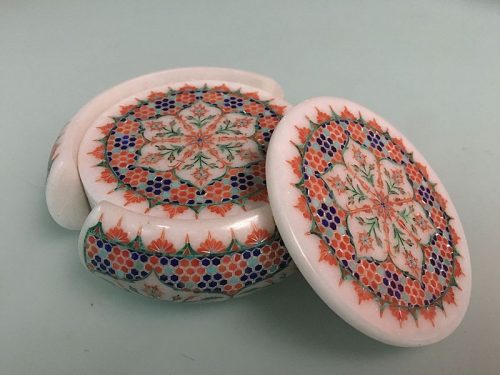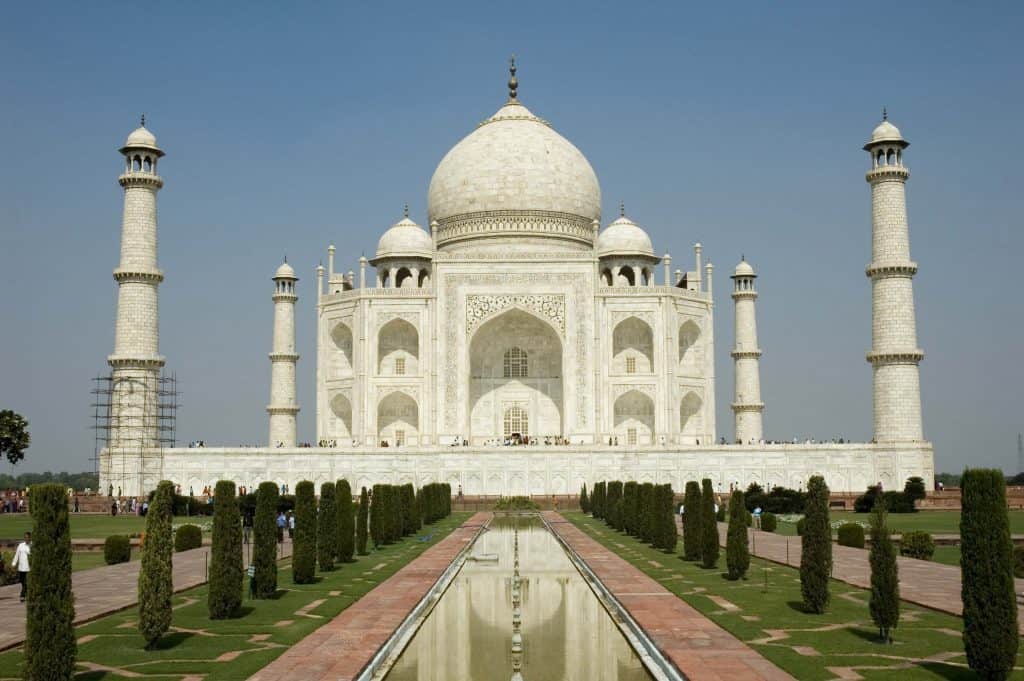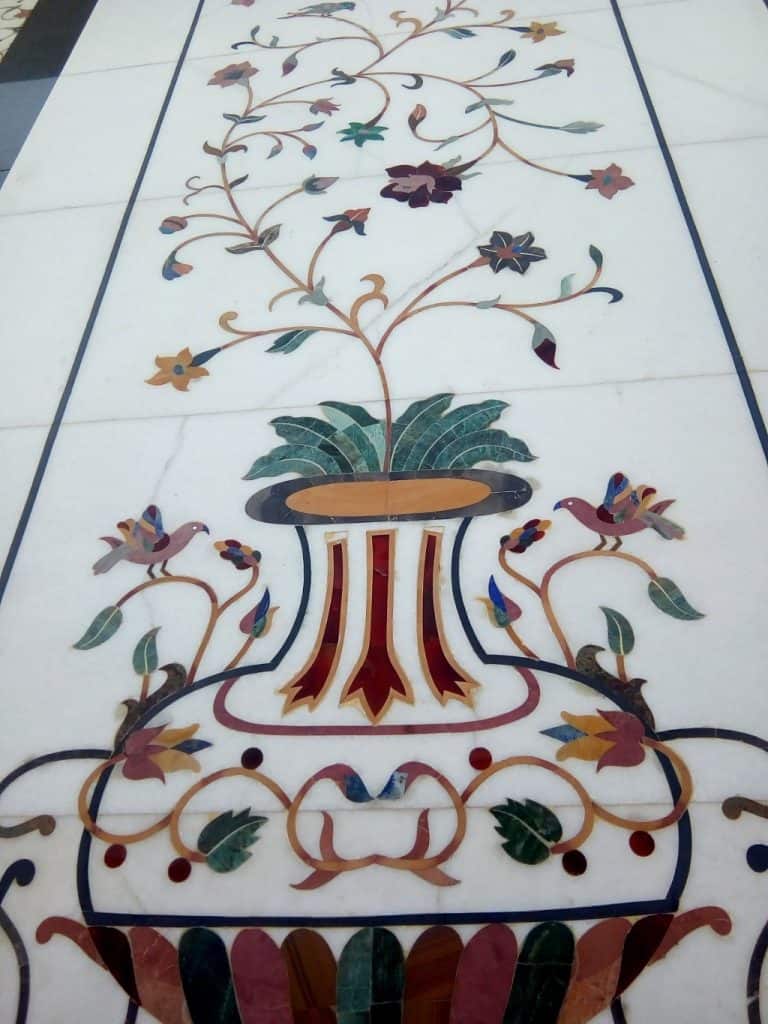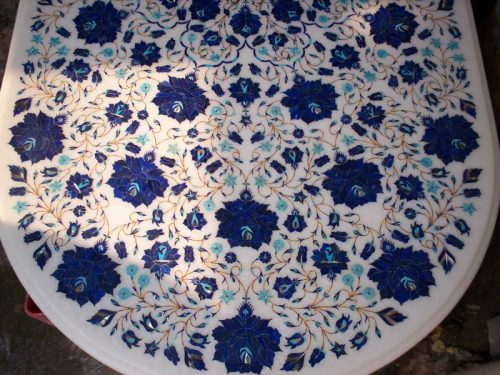Marble Inlay art fuses beauty and tradition, turning stone into mesmerizing masterpieces of unmatched elegance and detail.

Marble inlay, also known as “Pacchikari” or “Parchinkari,” is one of the most stunning and well-known types of Mughal art. It was indigenously produced in India. However, it is generally accepted that its roots are in Italy.
A marble that has been inlaid with motifs crafted out of precious or semi-precious stones is formally referred to as “pietra dura,” which is Italian for “hard stone.” Pacchikari, also known as the inlay of semi-precious stones like agate, turquoise, cornelian, jasper, bloodstone, mother-of-pearl, malachite, and lapis lazuli in marble, is an art form that can only be found in Agra.
The inlay is of such high quality that it gives the impression that the designs were carved directly into the marble. The incisions are so subtle that they are almost impossible to see. The stunning pietra dura work that was done on the Taj Mahal and the tomb of Itmud-ud-Daulah served as the source of inspiration for the trade.
The sequence of steps that eventually resulted in the realisation of a masterwork of inlay was honed by Mughal artisans in the 17th century, and it has remained relatively stable for over 400 years since then. This is because the Mughal artisans perfected the series of steps that culminated in the realisation of a masterpiece of inlay work in marble.
Even while the craft still made use of equipment and techniques from the Mughal period, the accuracy in workmanship that expert artisans attained thanks to their outstanding talents is not something that can be recreated by most machines in the contemporary day. Marble Emporium has ensured that the art is kept in its purest, most authentic form.
History of Marble Inlay
Inlay work, especially that done on marble or pietra dura, has been the subject of a great deal of discussion over its place of origin.
The origins of Pietra-Dura are somewhat mysterious—whether it was directly imported from Europe or introduced through another region remains unclear. What is certain is that it captivated Shah Jahan’s imagination profoundly, transforming his architectural endeavours into what resembled a magnificent treasure chest. Originally used to adorn palaces during the Renaissance in Italy, this exquisite art of stone inlay found a renaissance of its own upon reaching the shores of India.
Indian craftsmen successfully adapted it to their requirements, gave it an indigenous touch, and utilised the method to carve out classic Indian designs, which are now considered to be the crown jewels of Indian art.

Some people have the opinion that it grew slowly in India since we can see changes in the inlay work of the structures that were constructed throughout the reigns of Akbar, Jahangir, and then Shah Jahan. It is the first prominent structure in white marble, and its rich decoration in pietra dura gives the sense of a little valuable thing enlarged into a piece of architecture.
It is also the first building in the world to be constructed entirely of white marble. It shows the change from the time when Akbar’s buildings were made of simple red sandstone to the time when they were made of luxurious marble, with all the changes.
During the reign of Shah Jahan, the Musamman Burj, the Diwan-I-Aam, and the Diwan-I-Khas of Agra Red Fort, as well as the Taj Mahal, Agra, Red Fort, and Palaces, Delhi, were all examples of Mughal Inlay art at its most elegant and best stage. This was a phenomenon that never stopped happening in the field of Mughal Inlay art.
The procedure of working on marble inlay
White marble from Makrana, Rajasthan, or Crema Marfil from Italy is often the preferred choice for intricate inlay work due to its fine quality. If marble isn’t used, alternatives like black Kadappa stone or green marble are selected.
The inlay process starts with a design, possibly a floral or geometric motif, traced onto a brass sheet. This pattern is then transferred onto the marble surface. Following this, artisans meticulously carve the marble to prepare it for the inlay
Since the inlay process takes so much time, it takes the skills of many different professionals for each step. The method of pre-etching entails the shape of the marble, the composition of the individually designed pattern, and the covering of the marble with geru, a red mineral colour that enables the etched lines to stand out in contrast.
The next step is to cut the marble using the most basic of tools, which consists of a set of chisels and a predefined set of squares.
After that, thin slices of various coloured stones, both precious and semi-precious, are carefully arranged in the marble using an adhesive. Before setting the stone, the etched area is first filled with cement, then the marble is briefly heated, and lastly, the stone is arranged.
Coloured stone slices, both precious and semi-precious, are carefully shaped, polished, and then embedded into the carved marble using a strong adhesive. Sometimes, specific stones undergo heat treatment to enhance their colour, such as heating Jaisalmer Yellow stone to achieve a red hue.
Common stones used in this art include White Jasper, Chocolate Stone, various types of Marble and Bidasar, along with Lapis, Malachite, Ruby, and Amethyst among others.
To create the intricate components of the design, the semi-precious stones, such as malachite, cornelian, jasper, pearl, and coral, amongst others, are finely crushed and sculpted on an emery wheel that is handled by hand.

Once the inlay is securely in place and dried, the next steps are to polish the surface and edges to a gleaming finish. This polishing, done with a stone bar, ensures the shine endures for decades, leaving the piece splendid and ready for display. When an artist has a high level of talent, the decorations that they produce are more exact and intricate.
Contemporary displays of Marble Inlay
The craftsmanship of inlays and decorations has greatly advanced, significantly bolstered by modern marble decoration techniques and cutting-edge inlay machinery. Today, inlay marble crafts achieve a level of sophistication and precision that was once hard to imagine. This is largely due to the sophisticated equipment that not only speeds up the process but also ensures superior quality, allowing master craftsmen to produce exceptional work more efficiently.
Furthermore, the cost of these inlay marble works has decreased due to the use of these advanced marble inlay machines, which enhance precision and streamline production, delivering top-notch results quickly and efficiently.
Despite these technological advancements, the role of human creativity remains indispensable. It continues to drive innovation and excellence in the marble inlay process, constantly pushing the boundaries and refining the techniques used in marble craftsmanship.
Inlay stones are becoming popular for use in marble inlay products such as marble inlay flooring patterns, marble inlay boxes, marble inlay jewelry boxes, marble inlay tables, marble inlay flower vases, coffee tables and side tables with marble inlay patterns. Table tops come in many different colours and shapes, such as squares, rectangles, ovals, octagons, and so on. Along with its strikingly beautiful appearance, marble inlay flooring designs are by far the most popular option.

Inlays in marble, if chosen carefully in terms of pattern, style, and colour combination, are more than capable of lending an air of unrivalled opulence to the inside of any house. There are both black and white marble tiles available, but it is essential to choose the appropriate setting for their installation before proceeding. Even places like kitchens and hallways can benefit from the beauty of inlay work.
Inlay handicrafts endure
In Agra, close to the majestic Taj Mahal, approximately 3,000 to 4,000 marble carvers and inlay craftsmen reside, perhaps even more, nestled within the colonies of Nai ki Mandi and Gokulpura.
These artisans, about 4,000 strong, are the living pulse of a venerable tradition, crafting miracles from stone in these neighbourhoods. Artisans are broadly categorized into two groups: sadakars, who handle the basic shaping, and pachikars, who specialize in detailed inlay work.
While the preliminary cutting and carving are enhanced by machinery and performed by skilled sadakars, the more intricate inlay work is carried out by experienced pachikars. This specialized task demands a level of expertise akin to that required in the cutting and polishing of jewellery stones, utilizing chisels and grinding stones.
Tourists are welcomed into the workshops, usually located behind the storefronts, where they can witness firsthand the finesse of the karigars during inlay demonstrations. Here, they observe the artisans as they intricately cut and carve marble.
The resulting artwork is a blend of techniques—carving, inlaying, engraving, sculpting, and undercutting—a method where multi-layered decorative items are masterfully created from a single piece of stone.
Since the Taj Mahal is one of the most popular tourist destinations, the business of producing Pietra Dura relics in Agra, Uttar Pradesh is thriving. These artefacts include tabletops, medallions, elephants and other animal shapes, jewellery boxes, and other ornamental objects. Even though the patterns are more Persian than Roman or Medici, this form of art is very much alive and thriving in the Indian city of Agra.
Where to buy:
The primary destinations for purchasing marble artefacts in Agra include the areas surrounding the Taj Mahal complex, Sadar Bazaar, Kinari Bazaar, and Munro Road. At the Taj Mahal Complex, the Uttar Pradesh State Emporium, known as Gangotri, provides a variety of marble handicrafts at reasonable prices.
Marble inlay items are widely available across Agra’s bazaars, villages, stores, and emporiums, and can also be found in other regions like Rajasthan and the city of Varanasi. Additionally, numerous websites offer inlay products, with platforms like artefactindia.com and marble crafts being among the popular choices for these exquisite items.
Read more: Latest



